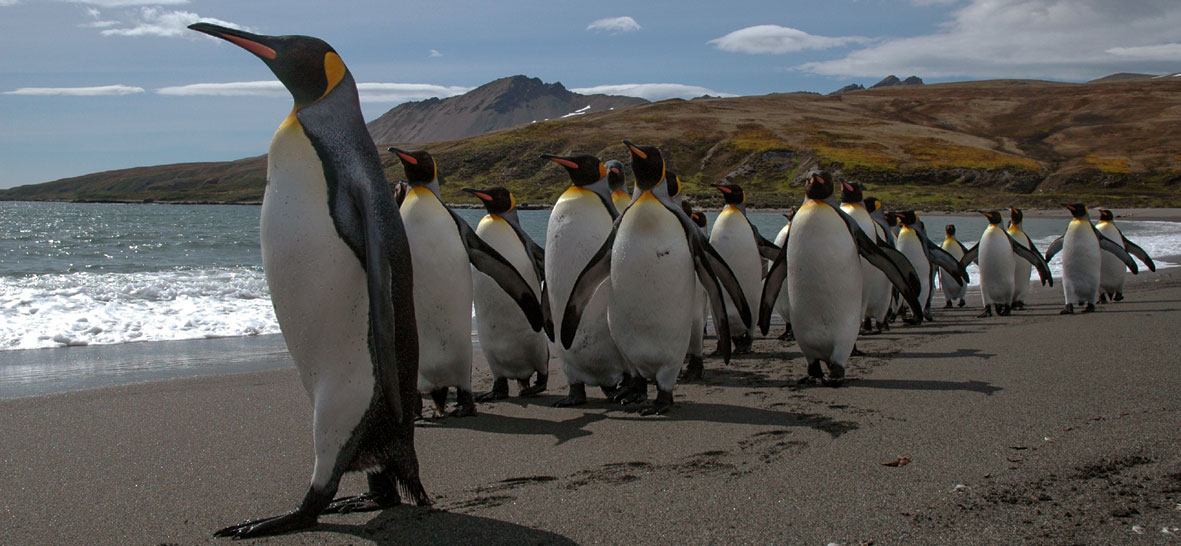SGSSI Environment
South Georgia & the South Sandwich Islands is a haven for wildlife. They are home to about five million seals of four different species, and 65 million breeding birds of 30 different species. Amongst these is the world’s only sub-Antarctic songbird, the endemic South Georgia pipit. Eleven of the 30 species of breeding birds on South Georgia are considered by the World Conservation Union (IUCN) to be threatened or near-threatened species. South Georgia is home to seven of the thirty species currently listed under the Agreement on the Conservation of Albatross and Petrels (ACAP).
The waters surrounding the islands are an important habitat for migrating whales and are host to a vast array of marine benthic fauna. They are also rich in fish species (including commercially important species) and are important for Antarctic krill populations which are a key link in the Southern Ocean food web.
Conservation of the pristine nature of the environment of SGSSI is at the heart of Government activities. Here’s a summary of how the Government of South Georgia & the South Sandwich Islands is protecting this UK Overseas Territory for wildlife and for people:
- The Government designated one of the world’s largest sustainable use Marine Protected Areas (MPAs) in 2012 which seeks to protect the marine life and maintain ecological processes while allowing sustainable fishing to the highest international standards. Extending over 1m km2 the MPA was designated on the basis of scientific evidence and protects biodiversity through >20,000 km2 of no-take zones and temporal and spatial protection measures that protect 92% of the sea floor and prohibit all fishing within 12nm of South Georgia and 3nm of the South Sandwich Islands. See the Government’s submission to the recent UK Environmental Audit Committee inquiry into Marine Protected Areas here;
- The fisheries are managed under the auspices of the Convention for the Conservation of Antarctic Marine Living Resources. The Government goes beyond the standards imposed by this international Convention meaning that it operates some of the best managed fisheries in the world. The South Georgia toothfish fishery received one of the highest Marine Stewardship Council (MSC) certifications and is a model for how sustainable fishing and environmental conservation can work hand in hand – essential for tackling the emerging global challenges of environmental degradation, climate change and growing global demand for food;
- The Government invests c.£1m in fisheries management and scientific research which helps to protect biodiversity each year. This underpins our precautionary fisheries management approach and Marine Protected Area. This investment is made possible as a result of revenue from our sustainable fishery. A unique collaboration between fishers, NGOs, scientists and Government means that no albatross are caught in the South Georgia fishery; this leadership has helped other nations improve their own sustainability saving thousands of albatross each year;
- The South Sandwich Islands are remote and little explored. Scientific research fishing takes place here which underpins the sustainability of the MSC-certified South Georgia fishery and deters illegal fishing which was previously common in the maritime zone. The MPA protects 1.3m pairs of Chinstrap penguins which breed here, one of the largest colonies in the world. The biggest current threats here are natural, arising from climate change, volcanic eruption and ice scour on the sea bed. We cannot protect against these but seek to undertake research and monitoring to inform our management;
- The Government has developed strict waste management protocols which must be implemented by all vessels visiting South Georgia, including fishing boats, cruise ships, military vessels and yachts, to prevent the introduction of any pollutants into the seas surrounding the islands. Long term monitoring of marine debris and current research into the impact of plastics which arrive at South Georgia from sources outside the maritime zone are being undertaken in collaboration with the British Antarctic Survey;
- The Convention on Biological Diversity was extended to South Georgia & the South Sandwich Islands in 2014. Following that, the Government published its National Biodiversity Action Plan which sets out an ambitious vision for conservation. The designation of a system of Terrestrial Protected Areas will form a key part of the National Biodiversity Action Plan. We are adopting an evidence-based and consultative approach with a view to ensuring appropriate levels of protection while facilitating sustainable tourism and scientific access;
- In early 2017 the Government launched an ambitious conservation effort to help protect the albatross. South Georgia is a globally important breeding site for a number of seabirds, including black-browed, grey-headed and wandering albatrosses. In its Conservation Action Plans the Government sets out its work with stakeholders, including the British Antarctic Survey and Royal Society for the Protection of Birds, to better understand the threats to these remarkable birds and protect them for future generations. The Government is engaging through partners to improve fishing practices internationally to save the albatross, including the Indian Ocean;
- A £7.5m rodent eradication project (the world’s largest) funded by the South Georgia Heritage Trust and supported by the Government concluded in 2015. While monitoring is taking place in 2017/18 to determine its success, the project has already delivered significant results with the South Georgia pipit, the world’s southernmost songbird, making a welcome resurgence. Additionally, the Government has committed £250k over the five year period to 2020 to tackle non-native plants. The Government invests in stringent biosecurity requirements to help protect the Territory from non-native invasive species and conducts hundreds of biosecurity checks on cargo each year.


